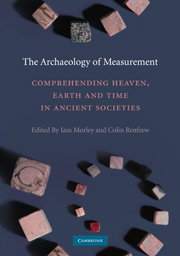Book contents
- Frontmatter
- Contents
- List of figures and tables
- List of contributors
- Acknowledgements
- The Archaeology of Measurement
- Introduction: Measure: Towards the construction of our world
- SECTION I NUMBER: COUNTING, MATHEMATICS AND MEASURE
- 1 Conceptualising quantification before settlement: Activities and issues underlying the conception and use of measurement
- 2 Measurement in navigation: Conceiving distance and time in the Neolithic
- 3 The token system of the ancient Near East: Its role in counting, writing, the economy and cognition
- 4 Grasping the concept of number: How did the sapient mind move beyond approximation?
- 5 Numerical cognition and the development of ‘zero’ in Mesoamerica
- 6 Recording measure(ment)s in the Inka khipu
- SECTION II MATERIALISING THE ECONOMY
- SECTION III DIMENSIONS AND BELIEF
- SECTION IV CALENDAR AND COSMOLOGY
- SECTION V THE SPIRITUALITY OF MEASURE
- Index
- References
1 - Conceptualising quantification before settlement: Activities and issues underlying the conception and use of measurement
Published online by Cambridge University Press: 05 June 2012
- Frontmatter
- Contents
- List of figures and tables
- List of contributors
- Acknowledgements
- The Archaeology of Measurement
- Introduction: Measure: Towards the construction of our world
- SECTION I NUMBER: COUNTING, MATHEMATICS AND MEASURE
- 1 Conceptualising quantification before settlement: Activities and issues underlying the conception and use of measurement
- 2 Measurement in navigation: Conceiving distance and time in the Neolithic
- 3 The token system of the ancient Near East: Its role in counting, writing, the economy and cognition
- 4 Grasping the concept of number: How did the sapient mind move beyond approximation?
- 5 Numerical cognition and the development of ‘zero’ in Mesoamerica
- 6 Recording measure(ment)s in the Inka khipu
- SECTION II MATERIALISING THE ECONOMY
- SECTION III DIMENSIONS AND BELIEF
- SECTION IV CALENDAR AND COSMOLOGY
- SECTION V THE SPIRITUALITY OF MEASURE
- Index
- References
Summary
Introduction
This chapter discusses a number of different aspects of measurement relevant to past societies, and the archaeological record. First, it explores some of the concepts underlying different types of measurement, the differences between them, and the implications of those differences for how measurement might be, and has been, conceived. Different types and concepts of measurement are labelled with specific terms, and the relationships between them considered. Whilst it is hoped that the concepts discussed and terms used might be useful in wider considerations of measurement, the chapter is written keeping in mind the nature and implications of the types of measurement activity that are likely to have been important in the context of hunter-gatherer subsistence, especially concepts of time, cycles and distance. In particular, this chapter seeks to highlight the fact that a great many of the activities that were carried out by past societies would have involved quantification in some form. In order to explore fully the use of measurement of the world and beyond in past societies we must explore the implications of the activities for which we do have archaeological evidence, in addition to looking for direct evidence of quantification.
The final sections of the chapter in particular relate some of these conceptualisations – especially of time and cycles of events – to supernatural and spiritual systems of belief for their explanation, and ritual systems of practice for their mediation.
- Type
- Chapter
- Information
- The Archaeology of MeasurementComprehending Heaven, Earth and Time in Ancient Societies, pp. 7 - 18Publisher: Cambridge University PressPrint publication year: 2010
References
- 5
- Cited by



